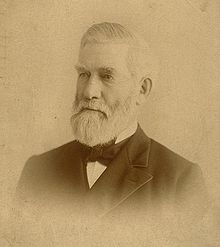Lorenzo Sawyer
| Lorenzo Sawyer | |
|---|---|
 |
|
| Judge of the United States Court of Appeals for the Ninth Circuit | |
|
In office June 16, 1891 – September 7, 1891 |
|
| Preceded by | Seat established |
| Succeeded by | Joseph McKenna |
| Judge of the United States Circuit Court for the Ninth Circuit | |
|
In office January 10, 1870 – June 16, 1891 |
|
| Appointed by | Ulysses Grant |
| Preceded by | Seat established |
| Succeeded by | Seat abolished |
| Chief Justice of the California Supreme Court | |
|
In office 1868–1870 |
|
| Preceded by | John Currey |
| Succeeded by | Augustus Rhodes |
| Personal details | |
| Born |
May 23, 1820 Le Roy, New York, U.S. |
| Died | September 7, 1891 (aged 71) San Francisco, California, U.S. |
| Political party | Republican |
| Education |
Case Western Reserve University Central College, Ohio |
Lorenzo Sawyer (May 23, 1820 – September 7, 1891) was an American lawyer and judge who was appointed to the Supreme Court of California in 1860 and served as Chief Justice of California from 1868–70. He served as a circuit judge for the U.S. Circuit Courts for the Ninth Circuit beginning in 1870 and later served as the first judge on the United States Court of Appeals for the Ninth Circuit from June 1891 until his death.
Sawyer was born on a farm in Le Roy, New York, the eldest of six children. He worked on the farm during the summer and attended the district school in winter. At the age of fifteen he attended, for a short time, a high school at Watertown, called the Black River Institute, where he became interested in the law. In 1837, having reached the age of seventeen, he went out on his own to pursue a course of study preparatory to commencing the study of law. The next eight years were devoted to preparation for the bar, at first in New York and afterward in Ohio. To support himself during this period, he taught in the district schools, and afterward in academies and as a tutor in college.
In 1840 he emigrated to Ohio, where he pursued his studies for a time at the Western Reserve College, and afterward continued his studies at Columbus and at Central College of Ohio near Columbus. He was admitted to the bar of the Supreme Court of Ohio in May 1846. He afterward went to Chicago, Illinois, where he passed a year in the office of future California Senator James A. McDougall. Soon afterward he entered into a law partnership with the Lieutenant-Governor John Edwin Holmes at Jefferson, Wisconsin, where he was rapidly acquiring an extensive and lucrative practice, when the California Gold Rush happened.
...
Wikipedia
